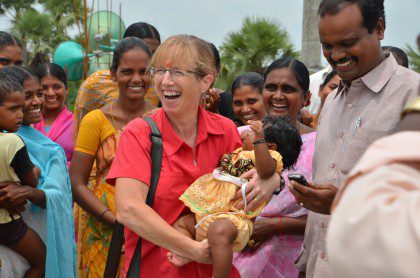
Click here to view a photo album from India
Mary Gorski, communications director for the U.S. Province, and Fr. Heru Ismadi, secretary general, had a whirlwind tour of the District of India after several days of workshops at Dehon Vidya Sadhan, Aluva, in the SCJs’ Indian District. Fr. Heru and Mary teamed up to do presentations on communications (including website development, use of social media and writing skills) and on the nuts and bolts of running an administrative office in the congregation. They were there from September 1-14. The following is Mary’s personal reflection on her time there. As she notes, stories about the people and ministries of India will be posted in the weeks ahead.
Prayers for electricity
I can’t believe that it has already been a month since I woke in Aluva, India, and quietly said a prayer for a morning of uninterrupted electricity and internet service.
And it has already been three weeks since I found myself stuck in a Mumbai traffic jam, slowly moving the 25 miles from the SCJ parish in Thane (adjacent to India’s most populous city of Mumbai) to the airport. In the two hours that it took to cover the distance I felt like each of the city’s 13 million inhabitants was on the road with us.
I went to India in early September with a two-fold purpose. The first was to assist Fr. Heru Ismadi, SCJ, secretary general, who was in the district to train several SCJs on the nuts and bolts of administration. Last year, most of the missionaries who held leadership positions in the district were forced to leave the country. While the young entity already had over a dozen ordained members and even more in final vows, few of these men had much experience in administration.
Fr. Heru came with a “Cliffs Notes’” version of how to run a district; in particular, how to operate a district office. I was there to give two days of workshops on communications including internal and external communication methods, article-writing, minute-taking and website development.
It was that last topic – the website – that had me at prayer only minutes after waking to the Hindu and Muslim calls to prayer outside my window at 5 a.m. and then to the prayer bells of the formation house.
Evidently no one sleeps late in India.
During the afternoon of the first day of the communications workshops we were to build a simple website. Although the district had a website, it had been dormant for about two years. Our hope was to create a new site that members of the district could take turns updating each week.
We started by establishing a district email address for communications.
And then the electricity went out.
The generator was revved up but then the internet connection went out. Adapting, we switched from website development to a quick workshop on how to take meeting minutes.
No electricity needed to move a pen across a piece of paper.
But wait, the modem light was back on! Back to website development. We picked a template from one of the free online website hosts. And just as we were to confirm the template the internet went out again. We said a few prayers for renewed internet service but I couldn’t remember who the patron saint of electronic communication was so we finally gave up, had some coffee, and decided to try again the next day.
The bells rang and we followed the students to prayer
I’m happy to report that on Tuesday our prayers were answered and we got through our session without any interruption of either power or internet service. We even had electricity through the afternoon so that we could enjoy a brief “Mr. Bean Goes to Church” video after lunch.
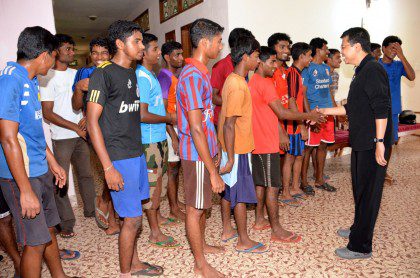
Personal thoughts
In the weeks ahead we will feature stories on the province website about the people and SCJ ministries of India. This was the second reason for my visit: to gather information about the district to share with SCJs at home, benefactors and co-workers. The U.S. Province provides significant financial support, and until recent years, personnel assistance to the entity. There is a strong bond between the U.S. Province and the Indian District.
But before the official stories go out I thought that I would share a few “unofficial” personal thoughts.
First, it was an incredible opportunity. For me, it is always a treat to be in a place totally different than what I know. I am lucky in that I can travel to such areas with a safety net: the SCJs. In India, as in other SCJ locations that I have visited, the members of the community treated me as a visiting princess, or at least as a dignitary, from the moment I arrived.
I walked out of the airport door and there was Fr. Thomas Vinod, SCJ, the district superior, ready to whisk me off to Dehon Vidya Sadhan, the formation house in Aluva. There, I was greeted by students who sang a song of welcome. It was a greeting I enjoyed at many SCJ houses, even in Punalur where the two SCJs who were home came out with a guitar to sing their welcome.
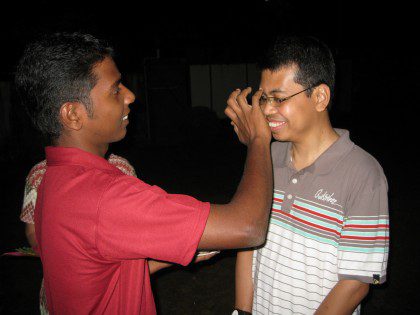
The second week our greetings included not only songs but beautiful flowered garlands and “bindi” dots on the forehead. I forgot to heed Fr. Tom Cassidy’s advice and wear dark colors. “Don’t forget, the flowers are beautiful but they leave a stain!” he told me. And so they did. I came home with a permanent reminder of my Indian visit: splashes of yellow and orange from garlands hung by SCJ seminarians in Eluru.
Always there were eager hellos and questions about SCJs from the United States. “Did you know Fr. Charlie, Fr. Tom Garvey?” “How is Br. Lenny?” “Tell Fr. Cassidy hello!”
[Fr. Tom Garvey was one of the pioneers of the district before his death in 2002 and Fr. Charlie Bisgrove ministered in India prior to his death last year. Br. Lenny Zaworski spent 10 years in the district before retiring.]Fr. Heru and I felt like we were on a general visitation. With Fr. Thomas as our host we traveled by bus, auto rickshaw, train, plane and several white-knuckled car rides to just about all of the SCJ locations in India from Aluva and Kumbalanghy in the south, to Mumbai and Eluru, which bookend India’s midsection.
We visited St. Anthony’s, a sub-parish in Thane, near Mumbai. Basically, the chapel was a barren second-story room with an altar, a coffee pot and a few religious objects. It was barren, except for the giggles of a trio of teen girls sitting on the floor working on a church project together. Youth ministry is one of the priorities of SCJs working in Mumbai. The community has only been in the area a few months and already young people are getting more involved in the church, “and bringing their parents with them,” said Fr. Aji, one of two SCJs who minister in the area.
That night it rained. Unlike most of the people who live near St. Anthony’s I was staying in a home that remained dry even during the worst of the storm. A parishioner at Divine Mercy Church, the church next to the SCJ residence in Thane, offered his guest rooms to me and Fr. Heru since there was little room for us in the community’s small apartment.
In the morning we opened the door to walk to Divine Mercy for Mass. Looking down we were greeted by at least a foot of water in the street. Yet after a week in India, we had learned to make do. We rolled up our pants and waded around the block to the church.
All I could think about on the way there were the people whom I had seen yesterday near St. Anthony’s, living in modest dwellings with only tarps and tin as protection from the rain. I assumed that most were not able to keep the majority of the rain out from their homes.
But in the midst of the flooded streets of Thane people came to a weekday morning Mass. Umbrellas and rolled pant legs were the uniform of the morning. Just another day in India. Rain never stopped the students in Aluva from playing their evening soccer game either. When I asked if games were ever cancelled Fr. Mariano, one of the formation directors said, “When you live in India, you just plan to get wet.”
You just adapt.
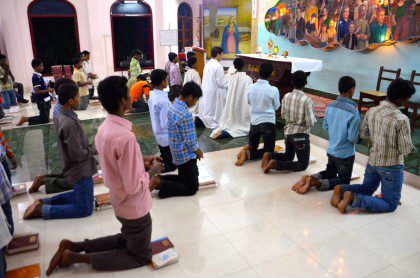
Students, students and more students
Although we did visit a few churches, such as the ones near Mumbai and others near Eluru, Kumbalanghy and Nambur, most of our stops were at formation houses. Distributed between aspirant, philosophy, postulancy, novitiate, theology and regency programs are over a 100 candidates and SCJs in formation. This is mind-boggling to someone coming from a Western country. In comparison I visited with the Dehon Formation Community in Chicago last week where the U.S. Province has two novices, two candidates and two SCJs in temporary vows.
In India I was asked about the formation program in North America and I cited the numbers in Chicago. An Indian SCJ told me that their numbers are beginning to decline as well, especially among women’s religious communities. At one point there were 38 Indian SCJs in theology whereas there are only about a dozen now. Yet still, compared to any other entity in the congregation India has an incredible number of men in formation.
As a side note, the men in formation put on great evening entertainment. At Christu Dehon Nivas in Eluru we were treated to an evening of dances, song and games as a part of our welcome to the community.
The hospitality button was always on
“Give me an example,” said one of my running buddies when I yet again talked about the wonderful sense of welcome that I felt in India.
Easy question. My first morning in India I walked into the dining room of Dehon Vidya Sadhan and saw cornflakes and peanut butter on the table. Neither is a staple of the Indian diet but my hosts assumed that it would help to make feel at home. Toast was stacked on a plate near my spot instead of the traditional chapati and rice.
I was incredibly grateful for the effort of having western food available to me but I did want to try some of the cuisine of my host country (not ALL but some; I’ll admit to a very Midwestern American stomach when it comes to hot spices).
Eventually I found compromise, mixing the American and Indian cultures together in a dish of peanut butter on rice.
Of course, there were many other signs of hospitality that went well beyond a jar of peanut butter. Gifts of clothing and other items too numerous to fit in my luggage. There was incredible enthusiasm from students and SCJs alike to learn about who I am and my home culture. But most of all, there was the gift of time. “Are you scheduled for anything on Saturday?” said Fr. Michael Benedict. Fr. Heru and I were both free before beginning travels on Sunday.
“Good, you need to experience the buses of India!” And off we went on a day of travels through Kochi and beyond. It was an adventure not found in any of the travel books I had skimmed before my visit to India.
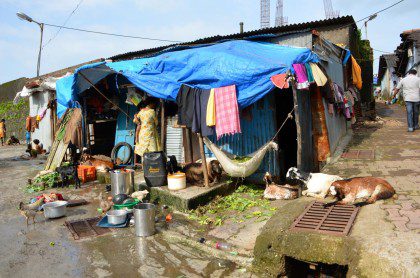
Challenges
I began this text by noting the intermittent power outages that are as common in Indian homes as rice is on its tables. It’s an anticipated annoyance that I hardly noticed after a few days. With a well-charged computer one can generally continue to work until the power pops back on again. Most people have cell phones. But even though I was used to it, whenever it went out it I was reminded of the many things that I take for granted at home in the United States.
In just about all of the SCJ communities of India the simple act of having a glass of water requires much more than turning a faucet handle. In most places, even in a large metropolis such as Thane near Mumbai, water is first boiled and then purified.
Distance is a significant obstacle. Attending a district council meeting in Aluva means that two of the councilors will have at least a 22-hour one-way train ride. If they get their tickets early they can get a sleeper car (which means that they have space on a sleeping platform stacked three high). If they can’t make their plans more than a few weeks out, they keep their fingers crossed and hope to get one of the spots held open for the travel date itself.
But I think that it is India’s diversity that is one of its greatest challenges, as well as one of its blessings.
Before leaving I was asked by several of the SCJs of my impressions of India. “What surprised you, what had the greatest impact?”
Evidently the students who took part in my workshop on interview skills were listening!
Although India left many impressions, the thing that surprised me the most was the extensive diversity in the country. I marvel at the many languages that the SCJs speak there. Fr. Thomas said that most members of the district need at least four languages: their home language, English for study, Hindi, and then the language of state in which they minister. For those who travel outside the country for education or ministry, there are other languages as well.
The Indian constitution recognizes 22 languages as official languages of the country. But there is no one language which is spoken throughout the nation. English is growing in popularity in many areas, especially for business and higher education. Hindi is spoken by the majority of Indians in the north, but it is not popular in southern India where Tamil, Telugu and Malayalam are more popular.
Sometimes I think that the citizens of Illinois are from a planet other than that of my home state of Wisconsin, but at least we speak the same language.
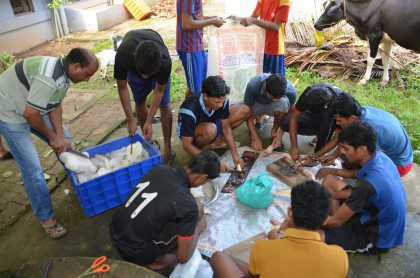
Exams or fish cleaning
I’ll close this lengthy write-up with one of my favorite lines overheard at Dehon Vidya Sadhan: “Third year students, you are dismissed. Good luck with your exams! First and second year students meet in the back to help clean the fish.”
I still laugh when I think of it, wondering how such a line would be received in the dining room of Sacred Heart School of Theology.
–Mary Gorski, communications director, US Province
Photos: Click here to view an album of photos from India.
And finally, a note: the SCJs in India hope to have their website up and running by the end of the year. When it is live, we will provide a link in Fridge Notes and on the province Facebook page.
